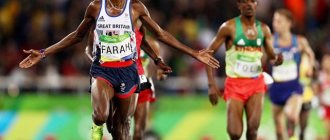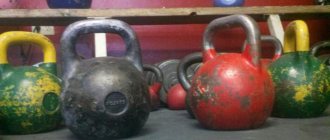Hello, friends!
If you're not completely new to running and are ready to tackle a challenging distance, try running a 10K. Such a distance requires not only strength, but also speed and willpower. While running, fat reserves are reduced, joints are strengthened, and sugar and cholesterol levels are reduced. What's not the motivation to try this sports discipline?
A person has a physical limit called “reaction speed”. Running 10 kilometers is a step towards “reaction speed”.
If running is easy, you can limit your running time to 52 minutes. If you have covered this distance, you must reduce the time.
Try to increase your results every day.
Running 10 km without training seems like an insurmountable obstacle. You need to prepare for this not only physically, but also mentally. Sit down and think about the distance, possible obstacles and, most importantly, realize that you need it!
Also when running: 1/3 of the distance you can run fast, 2/3 you are running moderately, then in the last third your body tells you to slow down.
Since we need to run for a long time, and we are tired and believe that this is not enough, we did not cover this distance in vain.
Mental strength is a necessary component when you run, especially over 10 kilometers.
Of course, running affects the respiratory system. A developed respiratory system will help in the future, other activities and hobbies.
It's about proper breathing. When we are tired, the intensity of breathing increases, the body requires a lot of oxygen. In the final stages, when it is already difficult to breathe, “hardening” of the lungs appears.
10 km running time standards
| Men's 10,000 meters (10 km) running standards | ||||||
| Ranks | Rank | |||||
| MSMK | MK | KMS | I | II | III | |
| 10 km stadium | 28: 06,0 | 29: 25,0 | 30: 35,0 | 32: 30,0 | 34: 40,0 | 38: 00,0 |
| 10 km by highway | 32: 50,0 | 35: 00,0 | 38: 20,0 | |||
| 10,000 meters (10 km) running standards for women | ||||||
| Ranks | Rank | |||||
| MSMK | MK | KMS | I | II | III | |
| 10 km stadium | 32: 00,0 | 34: 00,0 | 35: 50,0 | 38: 20,0 | 41: 30,0 | 45: 00,0 |
| 10 km by highway | 38: 40,0 | 41: 50,0 | 45: 20,0 | |||
The 10km distance is suitable not only for people who want to improve their conditioning, but also for those who intend to cross the line between maintaining normal fitness and more serious tests of strength.
To achieve excellent results, you must have a special strength and speed with which you can cover the distance to the end without any problems. How to prepare?
Running technique
Regarding the technique for achieving success in this discipline, we can say that all recommendations for the 200-meter running technique are ideal. In particular, you need to save your energy in the process of gaining speed and maintaining it. Such endurance directly depends not only on the level of physical fitness of the athlete, but also on compliance with the correct running technique, on correctly applied efforts in the required direction. Equally important is the ability to voluntarily relax or tense muscles depending on the phase of running.
The choice of running tempo is extremely important: at the start, athletes try to develop high speed in order to then switch to a swinging step. The time it takes to cover the first half of the distance for 400-meter runners is worse than when running the same distance in a 200-meter competition.
The difference in time to travel a given distance sometimes reaches one second. This is partly due to the fact that athletes save energy, since they need to run the remaining half of the distance at a good speed.
The 400-meter race involves two types of athletes: intermediates and sprinters. Sprinters try to cover the first half of a given distance much faster than the second half to take advantage of their speed advantage. Averages have good endurance, and this helps them maintain speed throughout the entire distance.
https://youtu.be/wTTDoqTJEhs
How to Run 10K: Key Points
Preparing for a 10 km run involves developing endurance. Everyone has their own physical limit, defined as a reaction norm. You can improve your results to the limit you need.
Running 10 km is just a step towards this norm. If you find it easy, you can limit the time (for example, 52 minutes). If you manage it in a short time, continue to reduce it further.
To improve your results, you need to understand the basic principles such as proper technique, warm-up, breathing and more. The fundamental point is the mental state. At first, 10 km may seem insurmountable. Think about distance and methods, and, very importantly, realize that you need it.
In the first part of the distance you can run more fun, in the second you can get quite tired, but in the third part your body may want to slow down. It is important to ignore this urge and continue - it is at this very moment that you train your brain. Mental toughness is a very important part of running, especially when it comes to long distances.
A very important point in learning to run 10 km is the development of breathing. You need to breathe through your nose, evenly and measuredly. In the last steps, when it is difficult to breathe, the lungs are strengthened.
When you run long distances, you may feel a tingling sensation on the left or right side and want to slow down. This moment is called "deadlock". It is important to overcome this, first of all, psychologically. Set a pace for yourself and speed up your arm movements, pulling your body forward. Take two steps inhaling and two steps exhaling.
The key is clothing that does not restrict movement. Make sure you tie your shoes correctly - it's important that you don't stop while running. It's better to run without music to focus on your breathing and distance.
The choice of route is also important. Beware of roads with traffic lights because you will have to make unnecessary stops. The road must be free of potholes.
If you can prepare yourself mentally and physically for a 10km run, you will be able to complete the distance, although it will be a difficult adjustment.
How to learn to run 400 meters
The distance, 400 meters long, is the longest sprint. To learn how to run 400 meters, you need to train your legs and be able to correctly distribute your strength over the distance.
Leg training for 400m running
Having strong legs is important for any sprinter. Therefore, at least half of the training time must be devoted to general physical training to train the leg muscles.
The following exercises are suitable for this: squats, squats with a barbell, “pistol”, lunges with a barbell or dumbbells, foot training, stepping on a support with dumbbells, leg press, etc. You can alternate them in different ways, but after doing 5-6 repetitions, you need to jog 100-200 meters to cool down. Then continue doing the exercises.
It is important to stop strength training no later than 2 weeks before the race itself, otherwise your legs may not have time to “run up”.
Explosive Strength Training for the 400 Meter Run
Explosive power is necessary for a quick start. Since 400 meters is, although long, but still a sprint, a quick start is no less important than completing the entire distance. He trains with jumping work. Such exercises include high jumps, “frog”, jumping on a support, jumping jacks, jumping from foot to foot, jumping rope.
Just as in the case of training leg muscles, jumping exercises must be “diluted” with periodic jogging. It is best to stop jumping no later than a week and a half before the start.
Speed endurance training for 400m running
Speed endurance is the most important component of running this distance. It is very important, after gaining speed at the start, to maintain it until the finish. It is best to train speed endurance by running segments of 200-400 meters 10-15 times with little rest.
More articles that may be useful to you: 1. Standards for smooth running 400 meters2. What is interval running3. Running technique4. Exercises to train your legs for running
Here are examples of work options to increase speed endurance:
10 times 400 meters, rest 3 minutes or 400 meters easy jog
15 times 200 meters, rest 200 meters with easy running or walking
20-30 times 100 meters with a rest of 1-2 minutes.
There are many options, the main thing is to understand the principle itself. It is also important to understand that for such a distance there is no need to run longer distances, say 600 or 800 meters, since this is not training for speed, but for general endurance, which is more needed by average athletes, not sprinters.
Tactical understanding of how to deploy forces at a distance of 400 meters
Very often, inexperienced athletes, and often professionals, make mistakes by starting too quickly. But by the finish line there is no strength left, and such runners are overtaken by those who have allocated their strength more competently.
In the 400-meter race, it is important to know your strength and understand how fast you need to run the distance so as not to “fall off” at the end of the journey. There is only one way to understand this - by running this distance. This is why competitive experience is important for an athlete.
You can structure one of your strength endurance workouts so that at the beginning of the workout, after warming up, you immediately try to run 400 meters at maximum strength. Then you will understand how fast you need to run. This can be done no later than 1.5 weeks before the start.
It is best to break down the forces at a distance as follows:
— Starting acceleration of 50-60 meters in order to take an advantageous position at the edge and accelerate your body from a resting position as quickly as possible.
- After that, look for your maximum speed, at which you understand that you will last the entire distance. So run 200-250 meters
— 100 m before the finish, you begin the finishing acceleration. Here the task is to move your legs as quickly as possible. Increasing the frequency of working with your hands will also help with this. Even if the work of the arms goes faster than the work of the legs, the legs will still try to “catch up” with the arms, and the speed will be faster.
Even without physical training, after just a month you can show a good result at a distance of 400 meters. It is advisable to train 4-5 times a week, alternating the load. That is, today you train leg strength, tomorrow you do jumping work, and the day after tomorrow you train strength endurance, after which you return to leg training. Two weeks before the start, exclude power legwork from your training and leave only running and jumping. And 1.5 weeks before the start, remove the jumping and leave only running. Three days before passing the standard or before the competition, leave in your training only a couple of runs of 100-200 meters and a good warm-up and cool-down. To improve your results in middle and long distance running, you need to know the basics of running, such as proper breathing, technique , warm-up, the ability to make the right preparation for the day of the competition, perform the correct strength work for running and others. Therefore, I recommend that you familiarize yourself with unique video lessons on these and other topics from the author of the site scfoton.ru, which you are currently on. For site readers, video tutorials are completely free. To receive them, just subscribe to the newsletter, and in a few seconds you will receive the first lesson in the series about the basics of proper breathing while running. Subscribe here: Running Video Tutorials. These lessons have already helped thousands of people, and they will help you too.
Good luck at the competition!
If you find an error in the text of the article, please let us know by highlighting the word or sentence with the error and pressing Shift + Enter or Here.
Related posts:
Author of the publication
Post navigation
Tagged 400m run, running lessons
scfoton.ru
Mistakes in the 10K Run
The most common mistake is a quick start. The distance is not that great. Often, in euphoria, the first kilometer or even two are run very quickly. That is, within 50 minutes, a person can run the first 2 km in 9 minutes, and the last one he simply crawls. So don't focus on the crowd. Keep your pace.
Another mistake is finishing early. You start to speed up if you realize that your running speed is very low and was incorrectly calculated. Or until the finish line exceeds 2 km.
Why choose running to lose weight?
The choice in favor of running is quite obvious. This is one of the easiest ways to give your body physical activity. It does not require special knowledge, it does not require special equipment, and even the absence of a treadmill near your home will not be a problem! You can run through the forest, park, even on the sidewalk. Some even run along highways (although this option is quite dangerous).
You can run in winter and summer, night and day, in sunny weather and in the rain! And even the lack of sports equipment for a person with a desire to run will not be a particular problem. And how could it be any other way, since with its obvious simplicity and minimal cost, running is the most effective means of losing weight?
World records in 10 km running
The overall men's 10,000m record is held by Ethiopian Kenenis Bekele, who ran the 10,000m around the stadium in 26:17.53 in 2005.
The world record is held by Kenyan runner Leonard Komon. In 2010, he covered 10 km at 26.44 meters.
Ethiopian runner Almaz Ayana, who completed 25 laps in 29:17:45m at the 2020 Rio Olympics, has a 10,000m overall.
The world record for 10 km is held by British athlete Paul Radcliffe. In 2003, he ran 10 km in 30.21 m.
Interval running is the best way to lose weight
To get used to running, start with interval training, alternating between running and walking. For example, in the early stages, alternate 1 minute of jogging with 5 minutes of intense walking. When your body gets stronger, move on to 3 minutes of jogging and 6 minutes of vigorous walking.
Even when your body endures serious loads, do not forget about interval running - after all, this is the most effective option in terms of burning fat. Alternate fast running for 1 minute with a calm, comfortable run for 5 minutes. This way you will not only break weight loss records, but also strengthen your heart muscle and blood vessels.
Important! If you don't want to do interval running and time yourself, just jog. It is this kind of leisurely running that contributes to the most efficient expenditure of calories, and also strengthens the respiratory system, heart muscle, and does not harm the knees and feet.
How much should you run to lose weight?
This question interests everyone who decides to run and burn fat mass at the same time. To start the process of lipolysis (burning fat cells), you need to run for at least 20 minutes!
The fact is that during the first 20 minutes of physical activity, the body takes energy from muscle and liver glycogen, and only then begins to consume fat cells accumulated in problem areas.
https://youtu.be/Hl-nPO1joZk
As for one full-fledged session, ideally you should run for at least 40, and preferably 50 minutes. Then you can say with all confidence that your activity contributed to getting rid of extra pounds.
Important! This information does not mean that you should run for 50 minutes from the first lesson. For beginners, it is better to start with a 10-minute workout, increasing the duration of exercise by 5 minutes every day. This way, it will be easier for the body to get used to the stress, which means that the person will have fewer reasons to break down and refuse to train.











